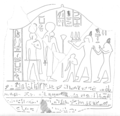| Libu in hieroglyphs | |||||||
|---|---|---|---|---|---|---|---|
rbw | |||||||

The Libu (Ancient Egyptian : rbw; also transcribed Rebu, Libo, or Lebu) were an Ancient Libyan tribe of Berber origin, from which the name Libya derives. [1]
| Libu in hieroglyphs | |||||||
|---|---|---|---|---|---|---|---|
rbw | |||||||

The Libu (Ancient Egyptian : rbw; also transcribed Rebu, Libo, or Lebu) were an Ancient Libyan tribe of Berber origin, from which the name Libya derives. [1]


Their tribal origin in Ancient Libya is first attested in Egyptian language texts from the New Kingdom, especially from the Ramesside Period. The earliest occurrence is in a Ramesses II inscription. [2] There were no vowels in the Egyptian script. The name Libu is written as rbw in Egyptian hieroglyphs. In the Great Karnak Inscription, the pharaoh Merneptah describes the Libu as men with pale complexion, tattooed, and with dark hair and eyes.[ citation needed ]
Hostilities between Egypt and Libya broke out in regnal year 5 (1208 BCE), but the coalition of Libu and Sea Peoples led by the chief of the Libu Meryey was defeated. [3] [4] Libu appears as an ethnic name on the Merneptah Stele , also known as the Israel Stele. [5]
Ramesses III defeated the Libyans in the 5th year of his reign, but six years later the Libyans joined the Meshwesh and invaded the western Delta and were defeated once again. [6]
This name Libu was taken over by the Greeks of Cyrenaica, who co-existed with them. [7] Geographically, the name of this tribe was adopted by the Greeks for "Cyrenaica" as well as for northwestern Africa in general. [8]
In the neo-Punic inscriptions, Libu was written as Lby for the masculine noun, and Lbt for the feminine noun of Libyan. The name supposedly was used as an ethnic name in those inscriptions. [9]
In the western Nile Delta, Libyan groups such as the Libu established some local chiefdoms under leaders titled Great Chiefs during the 24th Dynasty but these formations were short-lived. [10] During the 24th Dynasty, political authority had shifted to the prominent lineage of Libyan-descended rulers from the Great Ma tribe (short for Meshwesh), the Great Ma rulers governed as kings from Sais. The dynasty culminated with Tefnakht, who originally held the titles Great Chief of the West and Great Chief of the Ma, and who was of the Great Ma origin (or possibly Egyptianized) rather than Libu, before assuming royal status. [11] Later, Tefnakht adopted full pharaonic titulary, thereby founding the 24th Dynasty. [12]
They dated their monuments under the sovereign authority of the Great Ma rulers, following the regnal years of the pharaohs of the 22nd Dynasty of Ma origin. [13]
| Name | Image | Attested in regnal year... | Corresponding absolute datation | Notes |
|---|---|---|---|---|
| Inamunnifnebu |  | Year 31 of Shoshenq III [13] | 795 BCE | - |
| Niumateped |  | Year 4 of Shoshenq IV Year 8 of Shoshenq IV Year 10 of Shoshenq IV [14] | - BCE | Possibly two different rulers with the same name |
| Tjerpahati |  | Year 7 of Shoshenq V Year 15 of Shoshenq V [14] | 760 BCE 753 BCE | Also known in literature as Tjerper or Titaru, son of Didi |
| Ker |  | Year 19 of Shoshenq V [13] | 749 BCE | - |
| Rudamun | Year 30 of Shoshenq V [13] | 738 BCE | - | |
| Ankhhor | Year 37 of Shoshenq V Year ? of Shoshenq V [13] | 731 BCE ? BCE | Struggled against Tefnakht and was likely defeated by him | |
| Tefnakht |  | Year 36 of Shoshenq V Year 38 of Shoshenq V [13] | 732 BCE 730 BCE | - |
The seventy-nine line inscription is located on the interior of the east wall of the "Cours De la Cachette," directly north of a copy of the Hittite treaty from the reign of Ramesses II and in conjunction with other reliefs of Merneptah (PM II, p. 131 [486])... Unfortunately, the excavation of the Cours De la Cachette between 1978-1981 by the French expedition at Karnak did not discover any new blocks belonging to the Great Karnak Inscription of Merneptah, although it did demonstrate that the court was filled with many ritual and religious scenes in addition to its known military themes (F. LeSaout, "Reconstitution des murs de la Cours De la Cachette," Cahiers De Karrah VII (1978-1981) [Paris, 1982], p. 214).